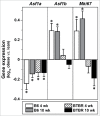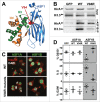Histone chaperone ASF1B promotes human β-cell proliferation via recruitment of histone H3.3
- PMID: 27753532
- PMCID: PMC5176155
- DOI: 10.1080/15384101.2016.1241914
Histone chaperone ASF1B promotes human β-cell proliferation via recruitment of histone H3.3
Abstract
Anti-silencing function 1 (ASF1) is a histone H3-H4 chaperone involved in DNA replication and repair, and transcriptional regulation. Here, we identify ASF1B, the mammalian paralog to ASF1, as a proliferation-inducing histone chaperone in human β-cells. Overexpression of ASF1B led to distinct transcriptional signatures consistent with increased cellular proliferation and reduced cellular death. Using multiple methods of monitoring proliferation and mitotic progression, we show that overexpression of ASF1B is sufficient to induce human β-cell proliferation. Co-expression of histone H3.3 further augmented β-cell proliferation, whereas suppression of endogenous H3.3 attenuated the stimulatory effect of ASF1B. Using the histone binding-deficient mutant of ASF1B (V94R), we show that histone binding to ASF1B is required for the induction of β-cell proliferation. In contrast to H3.3, overexpression of histone H3 variants H3.1 and H3.2 did not have an impact on ASF1B-mediated induction of proliferation. Our findings reveal a novel role of ASF1B in human β-cell replication and show that ASF1B and histone H3.3A synergistically stimulate human β-cell proliferation.
Keywords: ASF1B; cell cycle; histone H3.3; replication-independent histone deposition; β-cell proliferation.
Figures






Comment in
-
ASF1B chaperones histone 3.3 to the β-cell cycle dance.Cell Cycle. 2017 Jan 17;16(2):161-162. doi: 10.1080/15384101.2016.1260989. Epub 2016 Nov 18. Cell Cycle. 2017. PMID: 27860543 Free PMC article. No abstract available.
Similar articles
-
Distinct role of histone chaperone Asf1a and Asf1b during fertilization and pre-implantation embryonic development in mice.Epigenetics Chromatin. 2021 Dec 14;14(1):55. doi: 10.1186/s13072-021-00430-7. Epigenetics Chromatin. 2021. PMID: 34906203 Free PMC article.
-
In vivo study of the nucleosome assembly functions of ASF1 histone chaperones in human cells.Mol Cell Biol. 2008 Jun;28(11):3672-85. doi: 10.1128/MCB.00510-07. Epub 2008 Mar 31. Mol Cell Biol. 2008. PMID: 18378699 Free PMC article.
-
Roles of histone chaperone CIA/Asf1 in nascent DNA elongation during nucleosome replication.Genes Cells. 2011 Oct;16(10):1050-62. doi: 10.1111/j.1365-2443.2011.01549.x. Epub 2011 Sep 7. Genes Cells. 2011. PMID: 21895891
-
A Molecular Prospective for HIRA Complex Assembly and H3.3-Specific Histone Chaperone Function.J Mol Biol. 2017 Jun 30;429(13):1924-1933. doi: 10.1016/j.jmb.2016.11.010. Epub 2016 Nov 19. J Mol Biol. 2017. PMID: 27871933 Free PMC article. Review.
-
The histone chaperone Asf1 at the crossroads of chromatin and DNA checkpoint pathways.Chromosoma. 2007 Apr;116(2):79-93. doi: 10.1007/s00412-006-0087-z. Epub 2006 Dec 19. Chromosoma. 2007. PMID: 17180700 Review.
Cited by
-
Anti‑silencing function 1B promotes the progression of pancreatic cancer by activating c‑Myc.Int J Oncol. 2023 Jan;62(1):8. doi: 10.3892/ijo.2022.5456. Epub 2022 Nov 23. Int J Oncol. 2023. PMID: 36416310 Free PMC article.
-
NEXMIF overexpression is associated with autism-like behaviors and alterations in dendritic arborization and spine formation in mice.Front Neurosci. 2025 Jun 18;19:1556570. doi: 10.3389/fnins.2025.1556570. eCollection 2025. Front Neurosci. 2025. PMID: 40606839 Free PMC article.
-
ASF1B acted as a prognostic biomarker for stomach adenocarcinoma.Medicine (Baltimore). 2023 Dec 1;102(48):e35408. doi: 10.1097/MD.0000000000035408. Medicine (Baltimore). 2023. PMID: 38050219 Free PMC article.
-
Identification of Survival-Associated Hub Genes in Pancreatic Adenocarcinoma Based on WGCNA.Front Genet. 2022 Jan 3;12:814798. doi: 10.3389/fgene.2021.814798. eCollection 2021. Front Genet. 2022. PMID: 35047023 Free PMC article.
-
Contribution of histone variants to aneuploidy: a cancer perspective.Front Genet. 2023 Nov 23;14:1290903. doi: 10.3389/fgene.2023.1290903. eCollection 2023. Front Genet. 2023. PMID: 38075697 Free PMC article.
References
-
- Butler AE, Janson J, Bonner-Weir S, Ritzel R, Rizza RA, Butler PC. Beta-cell deficit and increased β-cell apoptosis in humans with type 2 diabetes. Diabetes 2003; 52:102-10; PMID:12502499; http://dx.doi.org/ 10.2337/diabetes.52.1.102 - DOI - PubMed
-
- Rankin MM, Kushner JA. Adaptive β-cell proliferation is severely restricted with advanced age. Diabetes 2009; 58:1365-72; PMID:19265026; http://dx.doi.org/ 10.2337/db08-1198 - DOI - PMC - PubMed
-
- Salpeter SJ, Khalaileh A, Weinberg-Corem N, Ziv O, Glaser B, Dor Y. Systemic regulation of the age-related decline of pancreatic β-cell replication. Diabetes 2013; 62:2843-8; PMID:23630298; http://dx.doi.org/ 10.2337/db13-0160 - DOI - PMC - PubMed
-
- Butler AE, Cao-Minh L, Galasso R, Rizza RA, Corradin A, Cobelli C, Butler PC. Adaptive changes in pancreatic β cell fractional area and β cell turnover in human pregnancy. Diabetologia 2010; 53:2167-76; PMID:20523966; http://dx.doi.org/ 10.1007/s00125-010-1809-6 - DOI - PMC - PubMed
-
- Georgia S, Bhushan A. Beta cell replication is the primary mechanism for maintaining postnatal β cell mass. J Clin Invest 2004; 114:963-8; PMID:15467835; http://dx.doi.org/ 10.1172/JCI22098 - DOI - PMC - PubMed
MeSH terms
Substances
Grants and funding
LinkOut - more resources
Full Text Sources
Other Literature Sources
Molecular Biology Databases
Miscellaneous
